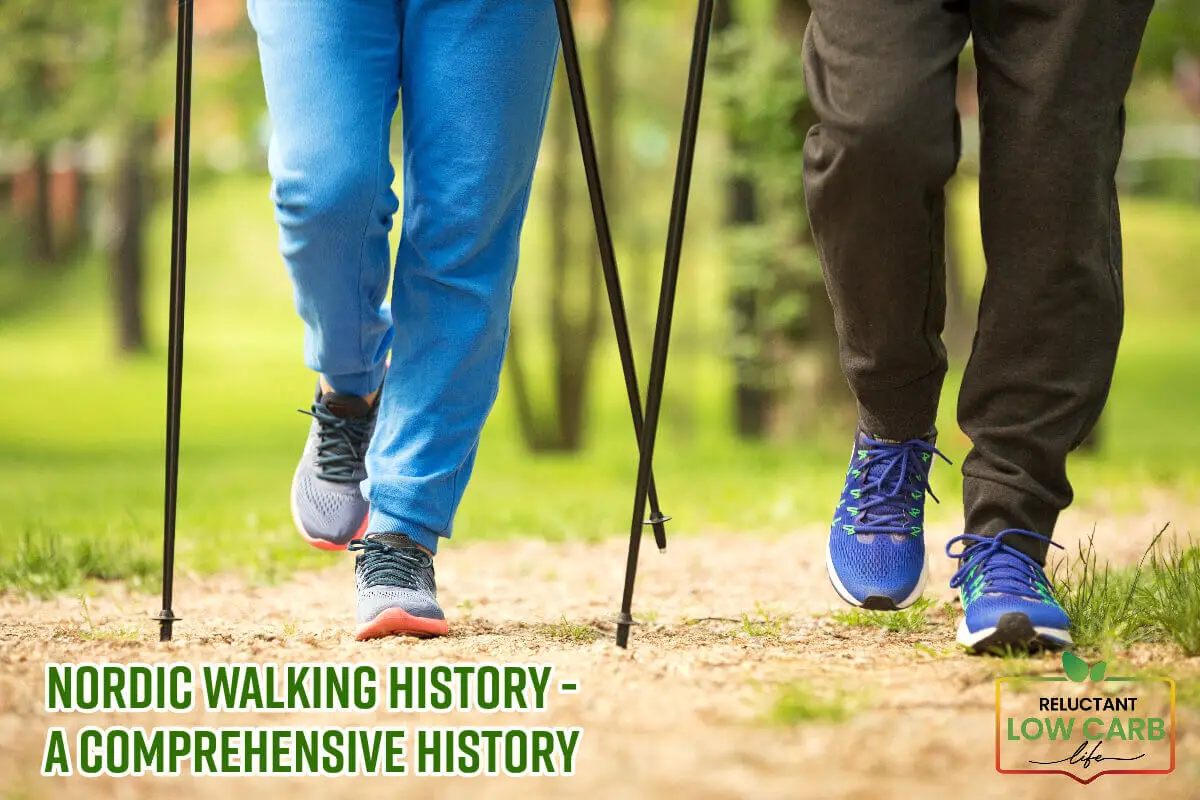Nordic walking involves the use of two poles that aid in propelling the walker forward. Health experts have extensively demonstrated that Nordic walking provides an outstanding exercise experience, offering numerous advantages compared to traditional walking.
The history of Nordic walking traces back to the 1960s in Finland. Still, an American coach named Tom Rutlin, renowned for his cross-country coaching expertise recognized the significance of using two poles in what we now know as the Exerstrider technique. Nonetheless, Finland is primarily credited with elevating Nordic walking to the recognized and popular sport it is today. Read on as we learn more about the history of Nordic Walking.
Table of Contents
- The Evolution and Global Rise Of Nordic Walking: A Comprehensive History
- Early Beginnings Of Pole Walking
- Tom Rutlin’s Exerstrider Technique: Pioneering A Fitness Revolution
- The Finnish Connection And Nordic Walking
- Nordic Walking And The Global Phenomenon
- Early Days In The United States
- Related Question
The Evolution and Global Rise Of Nordic Walking: A Comprehensive History
Walking is a fundamental human activity that has been practiced for centuries, serving as both a means of transportation and a form of exercise.
Over time, various adaptations of walking with poles have emerged, serving different purposes and fitness goals.
As we know it today, Nordic walking is a relatively recent development, born from a fusion of cross-country skiing techniques and innovative pole design. Read on as we delve into the rich history of Nordic walking, exploring its origins, evolution, and the reasons behind its rapid global popularity.

Early Beginnings Of Pole Walking
Walking with sticks and poles is nothing new. For centuries, people have had sticks to help them walk. For a long time, hikers have been trekking with poles.
What makes Nordic walking unique is its deep roots in cross-country skiing.
Nordic Walking’s Roots In Cross-Country Skiing
Most people credit Nordic walking as an exercise starting in Finland in 1966. Leena Jääskeläinen, a physical education teacher in Helsinki, introduced “walking with ski poles” into her students’ lessons. She also taught them exercises they could do with the poles and how they could use the poles to improve their fitness.
In the early 20th century, cross-country skiers sought ways to maintain their physical fitness during summer. Skiing enthusiasts recognized the benefits of engaging their upper body muscles while propelling themselves forward with ski poles.
They understood that to maintain their ski form during the summer season, they needed to also look at how to improve their upper body training and strength as well as their lower body training and strength. This led them to start to use poles in even the off-season.
This practice and desire to remain fit during the off-season by using ski poles laid the foundation for developing walking with poles as a fitness activity.
The Birth Of Exerstrider Technique
In 1985, an American cross-country skier and coach named Tom Rutlin significantly contributed to the evolution of pole walking. Rutlin combined the concept of fitness walking with a variation of his ski poles to create the “Exerstrider technique.”
This technique marked an early attempt to formalize the use of walking poles for fitness purposes, paving the way for further innovations.
Tom Rutlin’s Exerstrider Technique: Pioneering A Fitness Revolution
In fitness, innovation often arises from the most unexpected sources. Tom Rutlin, an American cross-country skier and coach, is one such innovator who made a lasting impact on the fitness industry by introducing the Exerstrider technique.
This revolutionary approach to fitness walking, born in 1985, has evolved into a popular and effective exercise regimen that combines the simplicity of walking with specially designed poles to engage the entire body.
The Birth Of Exerstrider
Tom Rutlin’s journey to creating the Exerstrider technique began with his deep passion for cross-country skiing. As a coach and skier, Rutlin recognized the need for a way to maintain physical fitness during the off-season when skiing was not possible.
He drew inspiration from his experiences with skiing, particularly the use of ski poles to propel himself forward and engage his upper body muscles.
The Innovation
In 1985, Rutlin decided to apply the principles of cross-country skiing to walking. He modified his ski poles to create walking poles explicitly designed for his new technique. These poles were equipped with rubber tips for traction on various surfaces and were adjustable to accommodate different heights and walking styles.
The Exerstrider technique was born out of this innovation, marking the inception of a fitness revolution. This started the Nordic Walking Revolution.
Understanding The Exerstrider Technique
At the heart of the Exerstrider technique are three core principles:
Full-Body Engagement:
Unlike traditional walking, where the lower body works most, the exercise technique involves the entire body. By pushing off with the poles, users engage their upper body muscles, including the arms, shoulders, and core, turning a simple walk into a full-body workout.
Natural Motion:
The Exerstrider technique prioritizes natural and fluid movements. Users maintain an upright posture, taking comfortable steps and swinging their arms in sync with their stride. This approach minimizes stress on joints while maximizing the efficiency of the exercise.
Adaptability:
One of the critical features of the Exerstrider technique is its adaptability to different fitness levels and goals. Whether you’re a beginner looking for a low-impact workout or an advanced athlete seeking an intense cardiovascular challenge, the Exerstrider technique can be tailored to meet your needs.
Benefits Of Exerstrider
There are many benefits to the exercise technique and why this technique, along with Nordic Walking, is such a great exercise.
Total Body Workout
One of the primary advantages of the Exerstrider technique is its ability to provide a comprehensive full-body workout. While walking alone primarily targets the lower body, incorporating walking poles engages the upper body muscles, resulting in improved muscle tone and increased calorie expenditure.
Low Impact
Exerstrider is a low-impact exercise, making it suitable for individuals of all fitness levels, including those with joint issues or injuries. The technique reduces stress on the knees and hips compared to running or high-impact aerobics.
Cardiovascular Benefits
The Exerstrider technique can be adapted to provide a cardiovascular workout. Users can elevate their heart rate and improve cardiovascular fitness by increasing the pace and intensity of walking with the poles.
Improved Posture And Balance
Using walking poles encourages users to maintain proper posture and balance. This can be particularly beneficial for individuals looking to improve their posture, stability, and overall body alignment.
Outdoor Enjoyment
Exerstrider offers a delightful way to enjoy the great outdoors while staying active. Whether you prefer walking in parks, on nature trails, or even around your neighborhood, the technique can enhance your outdoor experience.
Tom Rutlin’s Exerstrider technique is a testament to the power of innovation in the fitness world. By combining cross-country skiing with walking elements, Rutlin created an accessible and effective exercise regimen that engages the entire body.
The Exerstrider technique, known as Nordic Walking, provides a full-body workout, is adaptable to various fitness levels, and offers numerous health benefits—all while encouraging individuals to enjoy the beauty of the outdoors.

The Finnish Connection And Nordic Walking
Even though it was an American coach, Tom Rutlin, and his Exerstrider Technique that is credited with really taking walking with poles to a new level, most people see Finland as the birthplace of Nordic Walking as we know it today.
Collaboration Between A Sports Institute And A Ski Pole Company
Over a decade after Tom Rutlin’s Exerstrider technique, Nordic walking underwent a transformative period. In the spring of 1997, a collaboration between a Finnish sports institute and a ski pole company gave rise to a refined technique and specially designed high-performance poles.
This meaningful partnership would eventually give birth to the Nordic walking we know today.
The Birth Of Nordic Walking
The most widely recognized form of fitness walking with poles took shape in Finland. This new approach was aptly named “Nordic walking,” paying homage to its Scandinavian origins.
Finland’s meticulous research and engineering efforts laid the groundwork for a fitness activity that would soon take the world by storm.
Nordic Walking And The Global Phenomenon
Since the poles were produced commercially, Nordic walking has caught up globally, especially in Scandinavia, Europe, and Asia.
The Unparalleled Popularity Of Nordic Walking
Nordic walking’s rapid global rise and popularity are nothing short of astonishing. Unlike many fitness trends that come and go, Nordic walking has demonstrated remarkable staying power.
Being time-efficient, low-impact, socially engaging, and offering a full-body workout has made it an irresistible choice for people of all ages and fitness levels.
The Nordic Walking Movement
Scandinavians and Europeans, in particular, embraced Nordic walking with unparalleled enthusiasm. The activity’s versatility, ease of adoption, and proven health benefits contributed to its widespread acceptance. Chapter 4: Nordic Walking in America
Early Days In The United States
Although it was an American Cross country coach who understood the benefits of Nordic Walking, in America, it is not often you see people walking with poles in parks, communities, or roads.
I walk with my pole in my neighborhood in the United States, and many people still wonder what I am doing walking with two poles instead of just regular walking. I never see anyone else walking with the Nordic poles as I do.

The Future Of Nordic Walking In America
While Nordic walking is still relatively nascent in the United States compared to its European counterparts, its growth trajectory is promising. The global success and acceptance of Nordic walking and its numerous health advantages indicate that this fitness phenomenon is set to soar in popularity nationwide.
Nordic walking’s rich history is a testament to human innovation and the desire for a holistic approach to fitness. From its origins in cross-country skiing to the birth of the Exerstrider technique and its refinement in Finland,
Nordic walking has evolved into a global fitness phenomenon. Its unique blend of physical activity, social engagement, and health benefits has captivated individuals worldwide.
As Nordic walking continues to gain momentum in the United States and beyond, it is poised to become a staple in the world of fitness, offering people of all backgrounds a compelling way to stay active, healthy, and connected.
At Reluctant Low Carb Life, we are staunch advocates of the Health Trifecta: Fullness, Fitness, and Freshness. Additionally, we embrace the pillars of health, wellness, and graceful aging. Our mission is to provide honest and precise information to individuals dedicated to adopting a healthy lifestyle while enhancing their overall fitness and well-being.
We have a free monthly newsletter that is filled with information and helps you remain updated. Subscribe to the Reluctant Low Carb Life newsletter by clicking here.
Listen to our weekly podcast, Reluctant Low Carb Life, on all the major podcast platforms by clicking here.
Follow us on Instagram and Facebook by clicking here.
Related Question
What Does It Mean If You Crave Sugar On Keto?
Being on a keto diet should help you not to crave sugar. But some people who are on a keto diet may still crave sugar. There could be many reasons you still crave sugar, including eating hidden sugars in your foods and drinking too much diet soda. Or your keto diet includes too many carbs, or you are addicted to sugar.
You can read more about What Does It Mean If You Crave Sugar On Keto? by clicking here.
Yes, You Can Be Thin And Addicted To Sugar
Unsweetened almond milk should not make you fat. It is low in calories and has no carbohydrates or low sugars. When compared to whole milk, unsweetened almond milk is a much better type of milk to drink. The sweetened version of almond milk is higher in calories, carbohydrates, and sugars.
You can read more about Yes, You Can Be Thin And Addicted To Sugar by clicking here.
How Long Does It Take To Recover From Sugar Addiction?
Sugar can be a long addiction. It may be something that you deal with your entire life. But the good news is that giving up sugar will make it easier to overcome the addiction. You also need to find things you enjoy doing that can help replace sugar and sugary foods with healthy alternatives.
You can read more about How Long Does It Take To Recover From Sugar Addiction? by clicking here.








